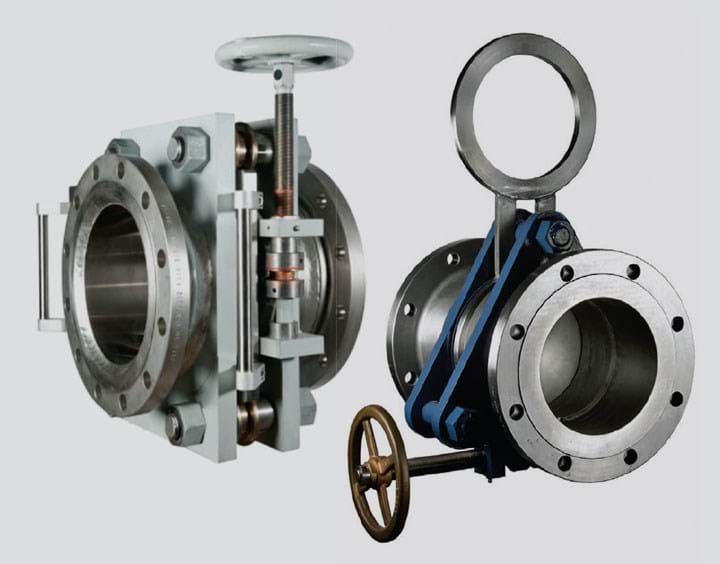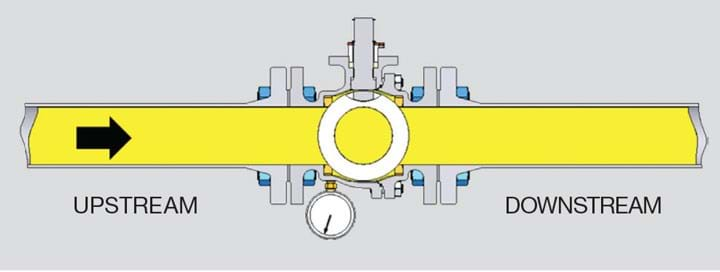Stopping the Flow
Rory Stanley explains developments in line blinding systems for total isolation
LINE blinding – or placing a solid steel gasketed plate between two flanges in a pipeline – is a well-established maintenance and safety procedure in the chemical, petrochemical and refining industries. The plate completely covers the bore, and is capable of withstanding the maximum pressure of the pipe with no leakage beyond the plate. Absolute closure or total isolation is achieved.
The main uses of spectacle blinds or line blinding systems (see Figures 1 and 2) are in tank farms, loading terminals or on main process lines in chemical or petrochemical plants. Given the flammable, toxic or explosive nature of media in many applications, maintenance can only be safely carried out if the line is absolutely closed off. While it is still a commonly-held belief that the use of isolation valves is sufficient to create positive flow shutoff, this is not always the case.
Valves leak by design?
Valves do leak. In fact, they leak by design. The standards that cover seat leakage for control valves (ANSI/FCI/70-2 1976(R1982)) allow 27 bubbles per minute, or 4 mL per minute for a 6” (DN150) valve. Likewise the API standard 598 for metal-seated Class VI valves allows for 12 drops per minute for liquids and 24 bubbles per minute for gas tests. These leakage rates do not seem too extreme at first glance. However, many isolation valves are Class IV or V that allow even greater leakage rates. The tragic consequences for the chemical industry range from cross contamination and pollution, to fires and explosions that can lead to fatalities, injuries and plant damage.

Valve leakage can lead to valve failure
This is one part of the story. Let’s consider a common plant activity - maintenance on a section of a process line (Figures 3 and 4). You don’t want to shut down the entire facility, so you decide to block off and depressurise just the section you’re working on. Just upstream is a double block and bleed (DB&B) valve – a ball valve with self-relieving seals and a bleed valve to vent the cavity, for example. You close the ball valve and open the bleed valve. Now you can de-pressurise the line downstream and open it up to work on it. You may think that the valve gives you double positive isolation, it is after all described as a “double block”, but it doesn’t – and that could be dangerous.
In the above ball valve example, API 6D defines this as a double block and bleed valve, not a double positive isolation (DPI) and bleed valve. Under normal conditions there is pressure on the upstream seal, which (along with an internal spring) keeps it energised. There’s no pressure on the downstream side, so the only thing energising the seal on the upstream side is a spring. The bleed valves are open, and the cavity in the ball is at atmospheric pressure. But it’s not uncommon for a valve that’s been in service for a while to leak a bit.
The upstream seal is leaking a little, but this should not be a problem because the leakage will be carried away by the bleed connection – except when the bleed valve is not working, either because one or both of the bleed valves is closed, or because there’s a clog in the bleed line. The pressure in the valve cavity can then possibly reach as high as 200 psi (1,379 kPa), which overcomes the spring on the downstream seal and forces it off its seat, discharging fluid downstream to where people may be working. This is clearly not a double positive isolation and bleed valve and the unfortunate worker downstream has no reason to suspect that the valve has failed.
So valves are designed to allow some small amount of leakage, but this can lead to valve failure in some cases.


DB&B does not achieve double positive isolation
Many people take the term “double block & bleed” (DB&B) to mean the same as “double positive isolation” (DPI). While this may seem like a small matter, it means that some users may think they’ve achieved total isolation when they haven’t. Many users have taken “double block and bleed” as a generic term, and tend to use it when they really mean (and the applicable specification, API 6D, Specification for Pipeline Valves, requires) use of double independent isolation, often referred to as “DPI”.
The job of double positive isolation is to stop process fluid from getting into an area where work is being done. This can be achieved by combining an in-line isolation valve and a line blind system as shown in Figure 5. Both the in-line valve and the blind would be closed, then the bleed port would be opened. If any fluid leaked past the first valve the bleed would drain it off before it pressurised the cavity - the space between the upstream and downstream valves – and at the same time would act as a tell-tale to indicate the leakage. If the bleed connection were to be plugged, the downstream line blinding system would keep process fluid from getting past it.
Recent Editions
Catch up on the latest news, views and jobs from The Chemical Engineer. Below are the four latest issues. View a wider selection of the archive from within the Magazine section of this site.




